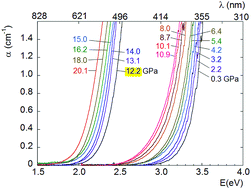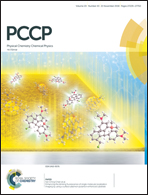Experimental and theoretical study on the optical properties of LaVO4 crystals under pressure†
Abstract
We report optical absorption and luminescence measurements in pure and trivalent neodymium (Nd3+) doped LaVO4 crystals up to 25 GPa. Nd3+ luminescence has been employed as a tool to follow the structural changes in the crystal. We also present band-structure and crystal-field calculations that provide the theoretical framework to accurately explain the observed experimental results. In particular, both optical absorption and luminescence measurements evidence that a phase transition takes place close to 12 GPa. They also provide information on the pressure dependence of the band-gap as well as the emission lines under compression. We found drastic changes in the optical properties of LaVO4 when the phase transition to a BaWO4-II structure occurs, which can be related to changes in the coordination number of vanadium ions and in the local sites of Nd3+. Reported results are analyzed in comparison with those of previous X-ray diffraction and Raman experiments, as well as with the features of related compounds. For the first time, a consistent picture is reported explaining the behavior of the optical and electronic properties of LaVO4 at high-pressures.

- This article is part of the themed collection: 2018 PCCP HOT Articles


 Please wait while we load your content...
Please wait while we load your content...